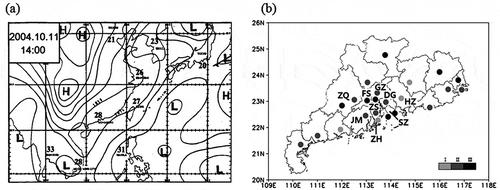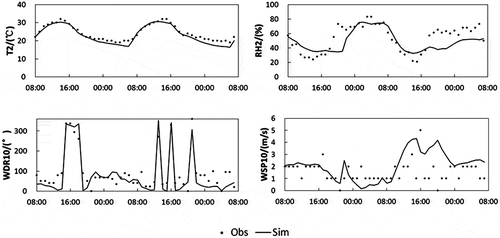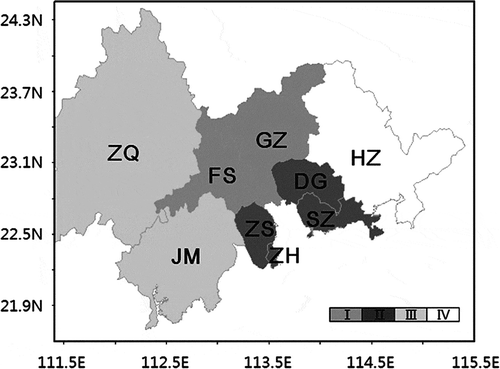Abstract
This study focuses on the influences of a warm high-pressure meteorological system on aerosol pollutants, employing the simulations by the Models-3/CMAQ system and the observations collected during October 10–12, 2004, over the Pearl River Delta (PRD) region. The results show that the spatial distributions of air pollutants are generally circular near Guangzhou and Foshan, which are cities with high emissions rates. The primary pollutant is particulate matter (PM) over the PRD. MM5 shows reasonable performance for major meteorological variables (i.e., temperature, relative humidity, wind direction) with normalized mean biases (NMB) of 4.5–38.8% and for their time series. CMAQ can capture one peak of all air pollutant concentrations on October 11, but misses other peaks. The CMAQ model systematically underpredicts the mass concentrations of all air pollutants. Compared with chemical observations, SO2 and O3 are predicted well with a correlation coefficient of 0.70 and 0.65. PM2.5 and NO are significantly underpredicted with an NMB of 43% and 90%, respectively. The process analysis results show that the emission, dry deposition, horizontal transport, and vertical transport are four main processes affecting air pollutants. The contributions of each physical process are different for the various pollutants. The most important process for PM10 is dry deposition, and for NOx it is transport. The contributions of horizontal and vertical transport processes vary during the period, but these two processes mostly contribute to the removal of air pollutants at Guangzhou city, whose emissions are high. For this high-pressure case, the contributions of the various processes show high correlations in cities with the similar geographical attributes. According to the statistical results, cities in the PRD region are divided into four groups with different features. The contributions from local and nonlocal emission sources are discussed in different groups.
Implications:
The characteristics of aerosol pollution episodes are intensively studied in this work using the high-resolution modeling system MM5/SMOKE/CMAQ, with special efforts on examining the contributions of different physical and chemical processes to air concentrations for each city over the PRD region by a process analysis method, so as to provide a scientific basis for understanding the formation mechanism of regional aerosol pollution under the high-pressure system over PRD.
Introduction
With the rapid economic development and urbanization of China, multipollutant pollution problems become increasingly serious in certain regions, including the Beijing–Tianjin–Tangshan region in North China, the Yangtze River Delta region in eastern China, and the Pearl River Delta (PRD) region in South China. PRD is characterized by city clusters with many cities of various sizes. The most important air pollution problem is the high concentrations of particulate matter (PM) emitted by the increasingly high anthropogenic releases of sulfur dioxide (SO2), nitrogen oxides (NOx), and volatile organic compounds (VOCs), ranging from urban to regional scale. Ozone episodes and haze pollutions were frequently observed over PRD according to the air quality monitoring, with more than 100 haze days per year (Guangdong Environmental Monitoring Center [GDEMC] and Hong Kong Environmental Protection Department [HKEPD], Citation2005–2010). Due to the impacts of PM (especially the fine particulate matter PM2.5) on human health, visibility, and climate change, PM2.5 was added to the daily measurements for regulations in China in 2011. In fact, many scientists have concentrated their efforts to understand O3 and PM pollutants over PRD and neighboring Hong Kong in previous decades (e.g., Fang et al., Citation1999; Cao et al., Citation2003; Louie et al., Citation2005; Ho et al., Citation2006; Duan et al., Citation2007).
The Program of Regional Integrated Experiments on Air Quality over Pearl River Delta (PRIDE-PRD), sponsored by the National Basic Research Program (2002CB410801 and 2002CB211605) from the Ministry of Science and Technology (MOST), China, is conducted to investigate the air pollution problem in PRD (Zhang et al., Citation2008). The PRIDE-PRD launched its first campaign PRIDE-PRD2004 from October 1 to November 4, 2004, with two well-equipped supersites, aircraft measurements, and 16 routine sites of the PRD regional air quality monitoring network. These valuable data sets make it possible to better understand the air pollution problem over PRD region. There are many studies based on this campaign, including boundary-layer meteorology (Fan et al., Citation2008, Citation2011), aircraft measurements (Wang et al., Citation2008), ground supersite measurements (Li et al., Citation2010), and radiative properties of aerosols (Garland et al., Citation2008; Liu et al., Citation2008) .
Investigations are also conducted with numerical simulations. Three-dimensional (3-D) air quality models are suitable for simulating the linkages between meteorology, emissions, and air pollution. Numerical simulations using U.S. Environmental Protection Agency (EPA) Community Multiscale Air Quality (CMAQ) model (Byun and Ching, Citation1999) have been conducted extensively around the world for both scientific studies and regulatory assessment (e.g., Zhang et al., Citation2004; Eder and Yu, Citation2006; Chen et al., Citation2007; Yu et al., Citation2008; Queen et al., Citation2008a, Citation2008b). Feng et al. (Citation2007) applied the MM5/CMAQ model to a PM pollution episode associated with the activity of tropical cyclone (TC) Melor over the PRD region. Model simulations revealed that Melor spawned this PM episode through dynamic and thermodynamic processes. The strong compensating subsidence induced by Melor’s peripheral circulation created favorable meteorological conditions that exacerbated the local aerosol pollution. Wei et al. (Citation2007) estimated the biogenic volatile organic compound emissions (BVOCs) in South China and their impact on the regional atmospheric chemistry with a tropical cyclone-related ozone episode with the CMAQ model. Their results showed that in the episode, apart from the enhancement of gas-phase chemical production of ozone, the surface deposition and vertical transport were also increased when BVOCs were included in the model. Chen et al. (Citation2009) used the CMAQ model to discuss the effect of sea–land breezes upon regional haze. The results showed that the sea–land breeze diurnal cycle played a significant role in the redistribution and the transport of PM. Nighttime land breeze scould transport PM to the coast and the sea, while daytime sea breezes could carry the accumulated PM offshore back to the inland cities. Kwok et al. (Citation2010) examined the influence of weather on pollutant concentrations in different seasons for Hong Kong and the PRD region with the CMAQ model.
From the numerical studies just described, it can be seen that weather phenomena, including local circulation, play an important role in determining local ambient pollutant concentration. The formation mechanism of aerosol pollutions of each city in PRD region should be different due to the complex meteorological and emission conditions and topography. High-resolution numerical simulations and diagnostic analysis methods are necessary to understand the similarities and differences for PM pollutants of various cities in PRD region.
The process analysis (PA) tool available in the CMAQ model is used to quantify the contributions from different physical processes and from chemical reactions to the concentrations of chemical species of interest (Jeffries and Tonnesen, Citation1994; Reynolds et al., Citation2003). The PA tool embedded in the CMAQ model has been widely used in the studies in United States and other countries (e.g., O’Neill and Lamb, Citation2005; Tonse et al., Citation2008; Khiem et al., Citation2010; Liu et al., Citation2011a, Citation2011b). Regarding studies in China, Xu et al. (Citation2008) used the PA method with the CMAQ-MADRID model to define the difference in O3-forming photochemistry between the urban area and its downwind area in Beijing, China. The results showed that the dominant process contributing to the O3 increase was different for each day. Liu et al. (Citation2010a, Citation2010b) applied the CMAQ modeling system with the PA tool to study the seasonal variations and formation mechanisms of major air pollutants with two nested domains. The coarse domain (36 km) covered East Asia and the finer domain (12 km) covered eastern China. PA results showed that PM10 was mainly produced by primary emissions and aerosol chemical processes and dispersed by horizontal transport. Cloud processes could either decrease or increase PM10 concentrations, depending on locations and seasons.
However, few studies use the PA tool to investigate the features of regional aerosol pollution over the PRD region in south China. In this study, CMAQ with the finest resolution (4 km) is applied to the PRIDE-PRD2004 intensive campaign episode for the period of October 10–12. The purposes of this study are to evaluate the ability of the CMAQ model to simulate ambient pollutant concentrations during an air pollution episode and to apply the PA tool to discern the different formation mechanisms of aerosol pollutants in various cities within the PRD region. In the second section, the model systems and methodology are described. The model evaluation and PA results are included in the third and fourth sections, respectively. The conclusions are presented in the fifth section.
Model Description and Methodology
Modeling system configuration and setup
The fifth-generation Pennsylvania State University-National Center for Atmospheric Research (NCAR) MM5 (Grell et al., Citation1994) was used to generate meteorological fields for air quality modeling. In this study, three domains (solid lines in ), centered in the PRD region, were configured on a horizontal grid of 65 × 49, 91 × 61, and 124 × 97 points with resolutions of 36, 12, and 4 km, respectively. The central latitude and longitude of the coarse domain (D01) were 23° N and 113° E, and the finest domain (D03) covered most of the cities in the PRD region (). For the model to adequately resolve the boundary-layer processes, 35 vertical levels up to 100 hPa, with 20 levels below 2000 m, are used in a terrain following σ-pressure coordinate system. The NCEP/NCAR 1° × 1° 6-hourly reanalysis daily gridded data were used to provide the lateral and initial conditions for the simulations. In the present study, the spinning up time used was 6 hr. The main physical options used in MM5 include the medium-range forecast (MRF) boundary-layer scheme, the Reisner microphysics scheme, the RRTM long-wave radiation scheme, and the five-layer soil model. The Betts–Miller cumulus parameterization scheme was used for 36- and 12-km grid domains. For the inner domains (D03), convection was assumed to be reasonably well resolved by the explicit microphysical parameterization scheme, and no cumulus parameterization scheme was used.
Figure 1. Three nested modeling domains for MM5 (solid square frame) and CMAQ (dashed square frame) models. (resolution is 36 km, 12 km, and 4 km, respectively) (b) The 4-km grid MM5 domain pointed with the main cities over Pearl River Delta region.
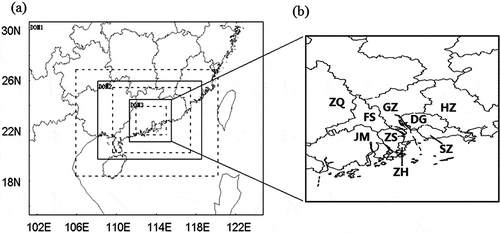
The Sparse Matrix Operator Kernel Emissions (SMOKE) model (Houyoux et al., Citation2004) was used to process point, area, and mobile emission sources for the air quality model. The point emission source data were updated from the point emission data collected by Feng et al. (Citation2007). Point sources are included in Guangdong province and its surrounding areas, including Guangxi, Fujian, Hainan, Jiangxi, Guizhou, Yunnan, and Hunan provinces. The point sources are subdivided into electric generating utilities (EGUs) and non-EGU sources. Examples of non-EGU point sources include chemical manufacturers and furniture refinishers. The inventories contain the major pollutants: CO, NOx, VOC, NH3, SO2, PM10, and PM2.5. The stationary area emissions in the SMOKE model are treated as being spread over a spatial extent but not moveable as compared to mobile sources. Examples of stationary area sources are residential heating and architectural coatings. The MOBILE6 module in the SMOKE model was used to calculate the mobile emissions by the vehicle miles traveled (VMT) method. The VMT data were prepared based on the vehicle type, road class, and vehicle mileage collected from various statistics sources. The annual emissions in the inventory file are processed by the SMOKE model to hourly emissions, speciation matrix, and gridding matrix. The merge step then combines the point, area, and mobile results to create model-ready emissions. The calculated emissions of PM10, SO2, and NOx in Guangdong province by the SMOKE model are shown in , which shows a similar spatial distribution of PM10, SO2, and NOx. There are three emission centers in Guangdong province: One is located in the middle region, including Guangzhou, Foshan cities; the second is situated in the east and north of Guangdong province, centered in Chaozhou and Shantou cities; and the third is located in the south and west region. Most emissions are from Maoming and Zhanjiang cities. There are also high emission sources in the northern part of Guangdong province, which is mostly from Shaoguan city.
Figure 2. The emissions of (a) PM10, (b) SO2, and (c) NOx in 2004 in Guangdong province calculated by the SMOKE model.
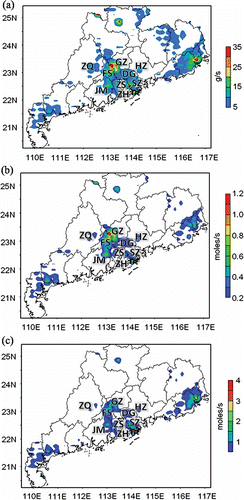
The air quality model used in this study is the U.S. EPA CMAQ model. It is an Eulerian-type model that addresses tropospheric ozone, acid deposition, visibility, particulate matter, and other pollutant issues in the context of a “one atmosphere” perspective. The simulations in this study were performed using CMAQv4.4 for October 10–12, 2004, with a 6-hr spin-up period. The CMAQ model was configured using the AERO3 aerosol module, EBI gas-phase chemistry solver module, ACM cloud module, and the carbon-bond mechanism version IV (CB-IV) chemical mechanism, including 36 species and 96 reactions, of which 11 are photolytic. The dashed square frame in shows the CMAQ modeling domain consisting of three nested domains with resolutions of 36, 12, and 4 km. The vertical layers for the CMAQ simulations collapses to 24 layers from 35 layers in meteorological simulations. For the coarsest CMAQ domain, typical profiles, which are provided together with the CMAQ source code, are used as initial and boundary conditions. For the inner two domains, the initial and boundary conditions are provided by the coarser domain. The meteorology–chemistry interface processor (MCIP) files processed from the MM5 hourly outputs and the output files from the SMOKE emission model were imported to the CMAQ chemical transport model (CCTM) to predict various pollutant concentrations.
Process analysis
The process analysis method embedded in CMAQ can be used to quantify the contributions by individual physical processes and chemical reactions to the concentrations of various chemical species, including the integrated process rates (IPR) that can identify dominant physical processes for pollutants and the integrated reaction rates (IRR) that can determine the most influential reactions for chemistry. In this paper, the IPR analysis tool was used. The hourly IPR results are analyzed for major pollutants to examine the relative importance of major atmospheric processes. The change in chemical species concentrations due to physical and chemical processes can be described in mass conservation equations as follows:
Classification method for cities
There are nine major cities in the PRD region (), including Guangzhou (GZ), Foshan (FS), Dongguan (DG), Shenzhen (SZ), Zhuhai (ZH), Zhongshan (ZS), Zhaoqing (ZQ), Huizhou (HZ), and Jiangmen (JM). To understand the similarities of PA results between different cities, a classification method was used to divide the cities into several types according to the PA results of each city. For example, when PA results show the main contributions being from emissions, horizontal transport, vertical transport, and dry deposition processes, then the total correlation coefficient will be calculated with eqs 2– 6. First, the sum of contributions from different processes will be calculated for each pollutant (PM10, SO2, and NOx) by eqs 2– 4. These three air pollutants were used in eqs 2– 4 because they are used in the calculation of the air pollution index (API) by the State Environmental Protection Agency (SEPA) of China. It should be noted that among the four processes already described, contributions from emission process for each city itself are caused by local emission sources, so this is not used in eqs 2– 4. Second, the total contribution for one city from three processes is calculated with the standard values from the contribution of each pollutant ( eq 5). Finally, the correlation coefficient is calculated between two cities with eq 6.
According to correlation coefficient (r) results, the cities were classified into the following groups. (1) If the r value between city A and city B is higher than those values between city A and other cities, then A and B are grouped as one type of city, and either the A or B city can be selected to represent this type of city. PA results of the A or B city can be used to analyze the contributions from different processes to air concentrations. (2) If r values between several cities are all high, then these cities can be grouped as one type of city. (3) If r values of one city with all other cities are all low, then this city can be treated as a unique city type.
Case Selection and Model Evaluation
Air pollutant episode selection
According to the statistical studies, the primary synoptic pattern causing regional air pollution episodes over the PRD region is the high-pressure system throughout the year (Zhou, Citation2012). Based on measurements from the PRIDE-PRD2004 intensity campaign, a high air-pollution episode during October 2004 was chosen for this study. During the PRIDE-PRD2004 intensive campaign period (from October 1 to November 4, 2004), for meteorological observations, the surface measurements of nine weather stations were collected, including temperature, relative humidity, wind speed, and wind direction. In addition, radio soundings were conducted at three stations (Qingyuan, Panyu, and Xinken) to derive the vertical profiles (Fan et al., Citation2008). For chemical observations, besides the conductive air concentrations (including SO2, NO, NOy, CO, and O3) measured by a TEI multigas analyzer at two supersites (Guangzhou and Xinken), PM2.5 concentration, and PM2.5 composition, aircraft measurements for vertical distribution of air concentrations were also archived. According to the average API (http://www.gdepb.gov.cn/oldsite/xcyjy/hjzs/daqi/200510/t20051020_18510.html) over the PRD region, which was defined by PM10, SO2, and NO2 required by SEPA of China, from October 3, 2004, the API began to increase and reached the maximum of 120 on October 11, 2004. It remained high during October 12–17 and then decreased from October 18, 2004.
In this study, the high air-pollution episode on October 10–12, 2004, was chosen to investigate the characteristics of regional air pollution and the contributions of different physical and chemical processes to air pollutant concentrations for various cities over PRD by the PA method in the CMAQ model. shows the surface-weather chart in East Asia at 14:00 a.m. on October 11, 2004. From this figure, several large synoptic systems are evident, including the inland high-pressure systems and the low-pressure system in the western North Pacific. The wind direction below the planetary boundary layer over PRD was from the north and the wind speed was comparatively low. Under such meteorological conditions, the air pollutants could accumulate and result in high concentrations. shows the daily average distribution of API in Guangdong province on October 11, 2004. The API values of nine observational stations exceeded the standard—which is to say, these cities were polluted and the primary pollutants were mainly particulate matter. Six of these nine polluted stations are located in the PRD region and mainly centered in Guangzhou city and its surrounding areas. It can also be seen from that most emissions are distributed in these polluted cities.
MM5 model evaluation
summarizes the performance statistics for MM5 meteorological predictions, including 2-m temperature (T2), 2-m relatively humidity (RH2), 10-m wind speed (WSP10), and wind direction (WDR10). The statistical variables include correlation coefficient (r), mean bias (MB), root-mean-squared error (RMSE), normalized mean bias (NMB), and normalized mean error (NME). The predictions in different horizontal resolutions are listed in . It can be seen that the differences between various resolution results were small. Here, the results from the finest resolution (4 km) were used to illustrate the model performance in the following. Overall, simulated T2, RH2, and WDR10 have r of 0.98, 0.69, and 0.92, respectively. The simulated results agreed reasonably well with the observations. However, MM5 overpredicts wind speed. The average wind speed by observation is 1.54 m/s, while the model result is 2.08 m/s. The wind speeds are overpredicted with the average NMB of 36.07% and the NME of 20.82%, respectively. The difference may be caused by urban effect, such as the effect of buildings and urban heat island not being represented well in the simple five-layer soil model in MM5. This should be improved in future studies to provide more accurate meteorological data for air quality modeling.
Table 1. Performance statistics of MM5 meteorological predictions during October 10–12, 2004, at Guangzhou station in different horizontal resolution
compares the temporal variations of simulated and observed T2, RH2, and wind vector at Guangzhou site. As shown in this figure, MM5 is able to reproduce the daily variations of those variables. The temperatures during these two days all reached the maximum 30°C or so at 14:00 a.m. and then decreased to 16°C in nighttime. The high relative humidity for these two days occurred from 8:00 p.m. to 8:00 a.m. the next day, which was approximately 80%. RH2 was underestimated by about 25% on the second simulation day by the MM5. The wind directions were almost from the northeast, which were represented well by the MM5. The MM5 can also capture the wind speed increasing process. For October 10–11, 2004, the wind speed was low, about 1–2 m s−1. After 12:00 a.m. on October 11, the wind speed increased, but the model simulated slightly stronger northerly wind than the observations.
CMAQ model evaluation
shows the temporal variations of PM2.5, SO2, NO and O3 at the Guangzhou site. Overall, the CMAQ model underestimates all the air pollutant concentrations.
Figure 5. Simulated (by CMAQ) and observed temporal variations of PM2.5, SO2, NO, and O3 at Guangzhou site during October 10–12, 2004.
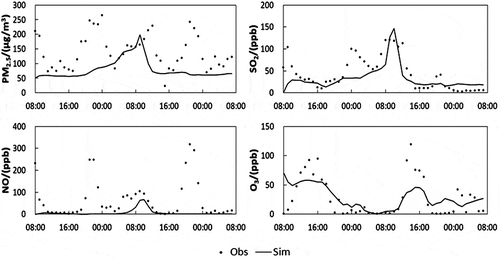
During October 10–12, 2004, there were three peaks in PM2.5 concentrations: in the nighttime on October 10 and 11, and at noon on October 11, respectively. CMAQ captures one peak on October 11, but misses the other two peaks. The temporal variations of SO2 are reasonably reproduced by CMAQ. The model captures the maximum of SO2 (100 ppb or so), which occurred during 9:00–10:00 a.m. on October 11, but also misses a peak in the nighttime on October 10. The CMAQ model predicts well the diurnal variation trends of O3. The magnitude of nighttime O3 mixing ratios is also consistent with the observations. However, the magnitudes of daytime peak O3 are lower than observations on these two days. Compared with observations, SO2 and O3 are predicted well with correlation coefficients of 0.70 and 0.65, respectively. PM2.5 and NO are significantly underpredicted with the NMB of 43% and 90%. In addition to the uncertainties in emission and meteorology input data, chemical speciation processing in the SMOKE model could be another source of uncertainty because values are not extracted from Chinese real activities. Chemical speciation processing in the SMOKE model not only is used to convert the emissions in terms of pollutant values to the species used in the chemical mechanism of CMAQ model, but also includes the ratio of all air pollutants and their compositions, such as the ratios of sulfate to PM2.5. The performance of NO by the CMAQ model is not satisfactory. Uncertainties in emission inventories of NOx and related species such as isoprene may contribute to the model biases. It should be improved for the application over the PRD region in the future.
Results and Discussion
Classification of the cities
The results from the PA method in the CMAQ model for the nine cities over the PRD region are all different. To understand the similarities and differences of PA results in the various cities, eqs 2– 6 were used to calculate a correlation coefficient to classify the cities into different groups. It should be pointed out that in this episode, the contributions to air pollutant concentrations from cloud, gas-phase chemistry, and aerosol processes were comparatively less than those from emission, horizontal transport, vertical transport, and dry deposition processes. Therefore, the contributions from cloud, gas-phase chemistry, and aerosol processes were not included in eqs 2– 6. shows the calculated r values between different cities. Besides r values, the spatial-distribution features of emissions () and the wind fields () are considered in the classification of cities. Finally four groups are defined as shown in . From , the maximum r value of GZ city with other cities is 0.32, which is the r value of GZ and FS cities. It can be seen from that there are high emissions in these two cities. Therefore, GZ and FS cities were divided into group I, representing the high-emission city group. DG, SZ, ZS, and ZH were classified into group II, representing the first downwind city group. It can be seen from that the dominant wind over PRD is from the northeast. The northeasterly wind passed through these cities and resulted in the transport of air pollutants. The r value of ZQ and JM is 0.60. These two cities were classified into group III, which is the second downwind city group. The r values of HZ with other cities are all very low, so HZ itself was defined into group IV, which represents the low-emission city group.
Table 2. The correlation coefficients between different cities calculated using eq 6
Results of process analysis
According to the classification already given, the PA results for GZ, ZS, JM, and HZ cities in each group were selected to be analyzed. shows the hourly contributions of horizontal transport (HORI), vertical transport (VERT), dry deposition (DDEP), and emissions (EMIS) to the concentration change of PM10, PM2.5, SO2, and NOx calculated by the PA method embedded in CMAQ during October 10–12, 2004. The contributions of these four processes are different for the different pollutants. In general, the emission process is the most important source for each pollutant. Besides the emission process, the peak concentrations of all species during 8:00 a.m.–12:00 p.m. on October 11 are much more influenced by the vertical transport process. The vertical velocities at 920 hPa, shown in with the horizontal wind fields, illustrates that the vertical velocities in most areas are negative, corresponding to the dominant sinking movement over PRD region, which was caused by a high-pressure system. Usually, vertical transport contributes to the removal of all species. Dry deposition process also contributes to the removal of all species, particularly for particle matter which is more often influenced by gravity. For the pollutants in , they all show peaks of dry deposition at noon on October 11, and these peaks may be caused by high air concentrations during this period. Higher air concentrations result in more dry deposition for given vertical velocities. The roles of horizontal transport depend on time of the day and on city. For example, it always contributes to the increase of concentrations for the cities in group III, but has the opposite effect for the cities in group I. It can be seen from that for GZ city, the contributions of horizontal transport are mostly negative. For ZS city, positive and negative contributions are comparable. For JM city, the horizontal transport contributes to the increase of air pollutant concentrations almost all of the time. For HZ city, the role of horizontal transport is minor when compared with other processes.
Figure 8. Hourly contributions of emissions (EMIS), dry deposition (DDEP), horizontal transport (HORI), and vertical transport (VERT) to the concentration change of PM10, PM2.5, SO2, and NOx predicted by CMAQ at (a) Guangzhou, (b) ZhongShan, (c) JiangMen, and (d) HuiZhou sites during October 10–12, 2004.
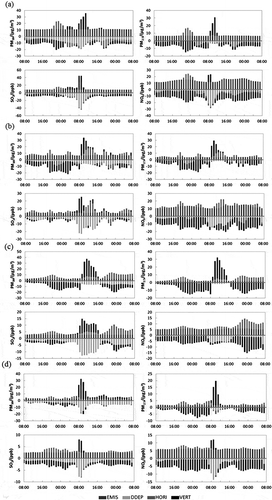
The similarities of PA results between cities in different groups were influenced by the dominant mesoscale meteorological conditions for this high-pressure system case, but their differences were caused by the local features, including the meteorological fields, the geography, and the emission distributions. For cities in group I, the local emissions were the most important factors contributing to high air pollution concentrations. The role of nonlocal emissions was minor because the contributions of horizontal transport were almost negative. For example, the contribution from emissions for PM10 in GZ city during the simulations was 11.2 μg/(m3-hr), and the contributions from dry deposition, horizontal, and vertical processes were –5.9 μg/(m3-hr), –1.8 μg/(m3-hr), and –2.2 μg/(m3-hr), respectively. The wind diluted the existing high air pollution concentrations caused by the emissions in these types of cities, while these cities were the contributors to the downwind cities. The first downwind cities in group II are the receptors from the upwind cities such as the cities in group I, but they are also the contributors to the second downwind cities. The contributions of horizontal transport process for these types of cities are complicated. Besides, it should be pointed out that the cities in group II are located near the Pearl River Estuary. Under a stable synoptic pattern, the local meteorological conditions, such as sea–land breeze, may also affect the transport of air pollutants. In the daytime, the sea breeze may decrease the outflow of air pollutants from these cities and then result in the positive contributions of horizontal transport in PA calculations. The effect would be the opposite in the nighttime under the influence of the land breeze. For the second downwind cities in group III, the increases of air pollutant concentrations were contributed from both local and nonlocal emissions. Sometimes the contributions from nonlocal emissions are greater than those from local emissions. Besides the effects of meteorological fields, the characteristics of emissions are also vital to the distribution of regional air pollution over the PRD region. Most emissions are distributed in the cities in group I and group II (). For the cities in group III, more air pollutants were carried in than were taken out, resulting in positive contributions of horizontal transport. For group IV, the positive contributions were mostly from local emissions. The local emission is less in this city than the emissions in other cities, and the contributions from transport processes were minor in this city because it is located upwind from the cities with large emissions.
To compare the roles of different processes in each city, the average contributions of EMIS, DDEP, HORI, and VERT to the concentration change of PM10, PM2.5, SO2, and NOx for nine cities over the PRD region during October 10–12, 2004, are shown in . As shown in , the contributions from emissions are greater for cities in group I (GZ and FS) and group II (DG, SZ, ZH, and ZS) than for cities in group III (ZQ and JM) and group IV (HZ). The differences between cities in contributions to NOx concentrations from emissions are comparatively less than those of other air pollutants because NOx more often results from mobile emission sources. shows that the negative contributions in GZ and FS cities from dry deposition process were greater because higher air pollution concentrations existed in these cities. The dry depositions are influenced by concentrations and dry deposition velocity. The different land-use types in each city are important for the dry deposition velocity. Compared with the other pollutants, the contribution from dry deposition for PM2.5 was small because fine particles can be suspended for longer time. In , the positive (negative) contribution designates the sources (sink) of air pollutants. For PM10 and PM2.5, the sources are GZ and DG; other cities are sinks of these two kinds of air pollutants. The sources of SO2 include GZ, FS, and DG. The sources of NOx are GZ, FS, DG, and SZ. These cities are all in group I and group II with high emissions (). When comparing the contributions from emission () and from horizontal transport () processes of GZ city in group I, it can be seen that the air pollution in GZ city is caused by local emissions. But for JM city in group III, it is obvious that the contribution from horizontal transport is comparable with those from emission, except for NOx. That is to say, in this kind of weather system, the air pollution in JM city is caused by both local and nonlocal emissions. In , the contributions from vertical process are negative in most cities. It also can be seen from that positive contribution of vertical processes only occurred during 8:00 a.m.–12:00 p.m. and resulted in air pollution concentration peaks on October 11. In other periods, the concentrations always decreased due to the vertical diffusion.
Figure 9. Average contributions of (a) emissions (EMIS), (b) dry deposition (DDEP), (c) horizontal transport (HORI), and (d) vertical transport (VERT) to the concentration change of PM10, PM2.5, SO2, and NOx predicted by CMAQ for nine cities over PRD during October 10–12, 2004.
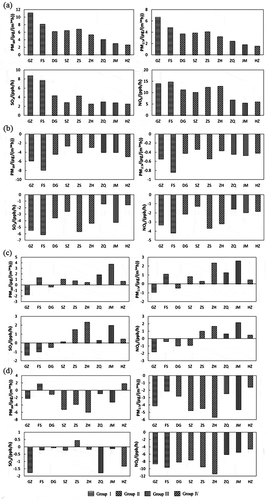
According to the PA results shown, GZ and FS cities in group I and DG city in group II should be considered good examples for the emission-control strategy over PRD region under the high pressure system. It should be noted that this study is limited to a high air pollution concentration episode caused by a high pressure system, which is the main dominant weather system for regional air pollution over PRD. Additional simulations during other weather systems would be useful for considering the emission-control strategy over PRD region.
Summary
Meteorological and chemical measurements from the PRIDE-PRD2004 campaign, simulations by the MM5-CMAQ model, and the process analysis method embedded in the CMAQ model were used to investigate an air pollution episode during October 10–12, 2004. The results show the following.
This air pollution episode was caused by a high pressure system, which is the main meteorological pattern causing regional air pollution over PRD. During this episode, the API values of six cities exceeded the national standard and the primary air pollutant was PM. Most air pollutants found in GZ, FS, and their surrounding areas, corresponded to the larger emission sources over PRD region.
The MM5–CMAQ model was applied to PRD region on October 10–12, 2004. The model evaluation, based on measurements, shows a reasonable performance of MM5. The correlation coefficients are 0.98 for T2, 0.69 for RH2, and 0.92 for WDR10 for Guangzhou city. The comparisons with the hourly data show moderate model performance in simulating the time series of meteorological fields. But the MM5 model overestimated the wind speed with the average NMB of 36.07% and the NME of 20.82%, respectively. For all the air pollutants evaluated, the CMAQ model underestimated the concentrations. SO2 and O3 are predicted well with the correlation coefficient of 0.70 and 0.65, respectively. PM2.5 and NO are significantly underpredicted with an NMB of 43% and 90%. The CMAQ model captured the peak of air pollutants during 8:00 a.m.–12:00 p.m. on October 11, but missed the other two peaks at nighttime. The significant underestimation by CMAQ might have been caused by the uncertainties in model inputs, such as emissions and meteorology and the default chemical speciation processing in the SMOKE model, which should be modified for the application over PRD region in the future.
PA results were used to calculate correlation coefficients to illustrate the similarities and differences between each city over PRD region. Four types of cities were classified according to the r values, the meteorological fields, and the spatial-distribution characteristics of emissions in PRD region. Group I included GZ and FS cities, represented as cities with high emissions and upwind locations. ZS, DG, ZH, and SZ cities were divided into group II, which were the first downwind cities and located near the Pearl River Estuary. Group III includes ZQ and JM cities. They are the second downwind cities. HZ is in group IV, and is a low-emission city.
In general, PA results show that main processes for air pollution concentrations are emission, dry deposition, vertical transport, and horizontal transport. The dominant contributions are from emissions. The dry deposition and vertical transport decrease the concentrations. But the peaks during 08:00 a.m.–12:00 p.m. on October 11, 2004, resulted from the vertical process because of the strong sinking movement in the PRD region caused by a high-pressure system. The roles of horizontal transport are different in each city.
The contributions from local and nonlocal emission were analyzed by comparing the calculation results from PA. For the cities in group I, the contributions from horizontal transport were almost negative, and air pollution in these cities was caused mostly by local emissions. For the cities in group III, the contributions from horizontal process were comparable with those from emissions. The nonlocal emission sources were important to these downwind cities. Sometimes the contributions from nonlocal emissions even exceeded those from local emissions.
Funding
This research was supported by funds from the National Natural Science Foundation (41275100 and 41275017), China National Basic Research and Development Programs (2002CB410801 and 2002CB211605), and National Natural Science Foundation of Guangdong Province as key project (S2012020011044).
Acknowledgments
The authors acknowledge the science team of the PRD October intensive campaign for their successful collaboration. The Network and Information Technology Center at Sun Yat-sen University is acknowledged for providing the use of computers in the research.
Additional information
Notes on contributors
Qi Fan
Qi Fan is an associate professor, Shaojia Fan and Xuemei Wang are professors, and Jing Lan and Delong Zou are graduate students at Sun Yat-sen University.
Wei Yu
Wei Yu is a research assistant at Dongguan Environmental Protection Monitoring Station.
Yerong Feng
Yerong Feng is a researcher at Guangzhou Central Meteorological Observatory.
Pak-wai Chan
Pak-wai Chan is a researcher at Hong Kong Observatory.
References
- Byun, D.W., and J.K.S. Ching. 1999. Science algorithms of the EPA Models-3 Community Multi-scale Air Quality (CMAQ) modeling system. Washington, DC: U.S. Environmental Protection Agency, U.S. Government Printing Office.
- Cao, J.J., S.C. Lee, K.F. Ho, X.Y. Zhang, S.C. Zou, K. Fung, J.C. Chow, and J.G. Watson. 2003. Characteristics of carbonaceous aerosol in Pearl River Delta region, China during 2001 winter period. Atmos. Environ. 37:1451–60. doi:10.1016/S1352-2310(02)01002-6
- Chen, D.S., S.Y. Cheng, L. Liu, T. Chen, and X.R. Guo. 2007. An integrated MM5-CMAQ modelling approach for assessing trans-boundary PM10 contribution to the host city of 2008 Olympic summer games—Beijing, China. Atmos. Environ. 41:1237–50. doi:10.1016/j atmosenv.2006.09.045.
- Chen, X.L., Y.R. Feng, J.N. Li, W.S. Lin, S.J. Fan, A.Y. Wang, S. Fong, and H. Lin. 2009. Numerical simulations on the effect of sea–land breezes on atmospheric haze over the Pearl River Delta region. Environ. Model Assess. 14(3): 351–63. doi:10.1007/s10666-007-9131-5
- Duan, J.C., J.H. Tan, D.X. Cheng, X.H. Bi, W.J. Deng, G.Y. Sheng, J.M. Fu, and M.H. Wong. 2007. Sources and characteristics of carbonaceous aerosol in two largest cities in Pearl River Delta region, China. Atmos. Environ. 41:2895–903. doi:10.1016/j. atmosenv.2006.12.017
- Eder, B., and S.C. Yu. 2006. A performance evaluation of the 2004 release of Models-3 CMAQ. Atmos. Environ. 40:4811–24. doi:10.1016/j.atmosenv.2005.08.045
- Fan, S.J., B.M. Wang, M. Tesche, R. Engelmann, A. Althausen, J. Liu, W. Zhu, Q. Fan, M.H. Li, N. Ta, L.L. Song, and K.C. Leong. 2008. Meteorological conditions and structures of atmospheric boundary layer in October 2004 over Pearl River Delta area. Atmos. Environ. 42:6174–6186. doi:10.1016/j. atmosenv.2008.01.067
- Fan, S.J., Q. Fan, W. Yu, X.Y. Luo, B.M. Wang, and L.L. Song. 2011. Atmospheric boundary layer characteristics over the Pearl River Delta, China, during the summer of 2006: Measurement and model results. Atmos. Chem. Phys. 11:6297–310. doi:10.5194/acpd-11-4807-2011
- Fang, M., M. Zheng, F. Wang, K.S. Chim, and S.C. Kot. 1999. The long-range transport of aerosols from northern China to Hong Kong: A multi-technique study. Atmos. Environ. 33:1803–17. doi:10.1016/S1352-2310(98)00318-5
- Feng, Y.R., A.Y. Wang, D. Wu, and X.D. Xu. 2007. The influence of tropical cyclone Melor on PM10 concentrations during an aerosol episode over the Pearl River Delta region of China: Numerical modeling versus observational analysis. Atmos. Environ. 41:4349–65. doi:10.1016/j. atmosenv.2007.01.055
- Garland, R.M., H. Yang, O. Schmid, D. Rose, A. Nowak, P. Achtert, A. Wiedensohler, N. Takegawa, K. Kita, Y. Miyazaki, Y. Kondo, M. Hu, M. Shao, L. M. Zeng, Y.H. Zhang, and M.O. Andrea. 2008. Aerosol optical properties in a rural environment near the mega-city Guangzhou, China: Implications for regional air pollution, radiative forcing and remote sensing. Atmos. Chem. Phys. 8:5161–86. doi:10.5194/acp-8-5161-2008
- Grell, G.A., J. Dudhia, and D.R. Stauffer. 1994. A description of the fifth-generation Penn State/NCAR Mesoscale Model (MM5). NCAR Tech., Note, NCAR/TN-398+STR, 138. Boulder, CO: National Center for Atmospheric Research.
- Guangdong Provincial Environmental Protection Monitoring Centre (GDEMC), and Environmental Protection Department of Hong Kong (HKEPD). 2005–2010. Pearl River Delta Regional Air Quality Monitoring Network report. http://www.epd.gov.hk/epd/english/resources_pub/publications/m_report.html
- Ho, K.F., J.J. Cao, S.C. Lee, and C.K. Chan. 2006. Source apportionment of PM2.5 in urban areas of Hong Kong, J. Hazard. Mater. B138:73–85. doi:10.1016/j.jhazmat.2006.05.047
- Houyoux, M., J. Vukovich, J.E. Brandmeyer, C. Seppanen, and A. Holland. 2004. SMOKE user manual version 2.1. Chapel Hill. NC: Carolina Environmental Program. October.
- Jeffries, H.E., and S. Tonnesen. 1994. A comparison of two photochemical reaction mechanisms using mass balance and process analysis. Atmos. Environ. 28:2991–3003. doi:10.1016/1352-2310(94)90345-X
- Khiem, M., R. Ooka, H. Hayami, H. Yoshikado, H. Huang, and Y. Kawamoto. 2010. Process analysis of ozone formation under different weather conditions over the Kanto region of Japan using the MM5/CMAQ modeling system. Atmos. Environ. 44:4463–73. doi:10.1016/j.atmosenv.2010.07.038
- Kwok, R.H.F., J. C.H. Fung, A. K.H. Lau, and J.S. Fu. 2010. Numerical study on seasonal variations of gaseous pollutants and particulate matters in Hong Kong and Pearl River Delta Region. J. Geophys. Res. 115. doi:10.1029/2009JD012809
- Li, X., T. Brauers, M. Shao, R. M. Garland, T. Wagner, T. Deutschmann, and A. Wahner. 2010. MAX-DOAS measurements in southern China: Retrieval of aerosol extinctions and validation using ground-based in-situ data. Atmos. Chem. Phys. 10:2079–89. doi:10.5194/acp-10-2079-2010
- Liu, P., and Y. Zhang. 2011a. Use of a process analysis tool for diagnostic study on fine particulate matter predictions in the U.S. Part I: Model evaluation. Atmos. Pollut. Res. 2:49–60. doi:10.5094/APR.2011.007
- Liu, P., and Y. Zhang. 2011b. Use of a process analysis tool for diagnostic study on fine particulate matter predictions in the U.S. Part II: Analyses and sensitivity simulations. Atmos. Pollut. Res. 2:61–71. doi:10.5094/APR.2011.008
- Liu, X.G., Y.F. Cheng, Y.H. Zhang, J.S. Jung, N. Sugimoto, S.Y. Chang, Y.J. Kim, S.J. Fan, and L.M. Zeng. 2008. Influences of relative humidity and particle chemical composition on aerosol scattering properties during the 2006 PRD campaign. Atmos. Environ. 42:1525–36. doi:10.1016/j. atmosenv.2007.10.077
- Liu, X.H., Y. Zhang, S.H. Cheng, J. Xing, Q. Zhang, D.G. Streets, C. Jang, W.X. Wang, and J.M. Hao. 2010a. Understanding of regional air pollution over China using CMAQ, part I performance evaluation and seasonal variation. Atmos. Environ. 44:2415–26. doi:10.1016/j. atmosenv.2010.03.035
- Liu, X.H., Y. Zhang, J. Xing, Q. Zhang, K. Wang, D.G. Streets, C. Jang, W.X. Wang, and J.M. Hao. 2010b. Understanding of regional air pollution over China using CMAQ, Part II. Process analysis and sensitivity of ozone and particulate matter to precursor emissions. Atmos. Environ. 44:3719–27. doi:10.1016/j.atmosenv.2010.03.036
- Louie, P.K.K., J.G. Watson, J.C. Chow, A. Chen, D.W.M. Sin, and A.K.H. Lau. 2005. Seasonal characteristics and regional transport of PM2.5 in Hong Kong. Atmos. Environ. 39:1695–710. doi: 10.1016/j. atmosenv.2004.11.017
- O’Neill, S.M., and B.K. Lamb. 2005. Intercomparison of the community multiscale air quality model and CALGRID using process analysis. Environ. Sci. Technol. 39:5742–53. doi:10.1021/es048403c
- Queen, A., and Y. Zhang. 2008a. Examining the sensitivity of MM5-CMAQ predictions to explicit microphysics schemes and horizontal grid resolutions, Part II—PM concentrations and wet deposition predictions. Atmos. Environ. 42:3856–68. doi:10.1016/j. atmosenv.2007.12.066
- Queen, A., and Y. Zhang. 2008b. Examining the sensitivity of MM5-CMAQ predictions to explicit microphysics schemes and horizontal grid resolutions, Part III—The impact of horizontal grid resolution. Atmos. Environ. 42:3869–81. doi:10.1016/j. atmosenv.2008.02.035
- Reynolds, S.D., C.L. Blanchard, and S.D. Ziman. 2003. Understanding the effectiveness of precursor reductions in lowering 8-hr ozone concentrations. J. Air Waste Manage. Assoc. 53:195–205. doi:10.1080/10473289.2003.10466143
- Tonse, S.R., N.J. Brown, R.A. Harley, and L. Jin. 2008. A process-analysis based study of the ozone weekend effect. Atmos. Environ. 42:7728–36. doi:10.1016/j.atmosenv.2008.05.061
- Wang, W., L.H. Ren, Y.H. Zhang, J.H. Chen, H.J. Liu, L.F. Bao, S.J. Fan, and D.G. Tang. 2008. Aircraft measurements of gaseous pollutants and particulate matter over Pearl River Delta in China. Atmos. Environ. 42:6187–202. doi:10.1016/j.atmosenv.2008.06.001
- Wei, X.L., Y.S. Li, K.S. Lam, A.Y. Wang, and T.J. Wang. 2007. Impact of biogenic VOC emissions on a tropical cyclone-related ozone episode in the Pearl River Delta region, China. Atmos. Environ. 41:7851–64. doi:10.1016/j.atmosenv.2007.06.012
- Xu, J., Y.H. Zhang, J.S. Fu, S.Q. Zheng, and W. Wang, 2008. Process analysis of typical summertime ozone episodes over the Beijing area. Sci. Total Environ. 399:147–57. doi:10.1016/j.scitotenv.2008.02.013
- Yu, Y., R.S. Sokhi, N. Kitwiroon, D.R. Middleton, and B. Fisher. 2008. Performance characteristics of MM5–SMOKE–CMAQ for a summer photochemical episode in southeast England, United Kingdom. Atmos. Environ. 28:4870–83. doi:10.1016/j. atmosenv.2008.02.051
- Zhang Y.H., M. Hu, S.C. Liu, and A. Wiedensohler. 2008. The special issue on PRIDE-PRD2004 Campaign. Atmos. Environ. 42:6155–56. doi:10.1016/j. atmosenv.2008.07.001
- Zhang, Y., B. Pun, S.Y. Wu, K. Vijayaraghavan, and C. Seigneur. 2004. Application and evaluation of two air quality models for particulate matter for a southeastern U.S. episode. J. Air Waste Manage. Assoc. 54:1478–93. doi:10.1080/10473289. 2004.10471012
- Zhou, J.F. 2012. Study on the influence of boundary-layer meteorological conditions on air quality over the Eastern Region of the Pearl River Estuary (in Chinese). Sun Yat-Sen University master’s thesis. 85.

